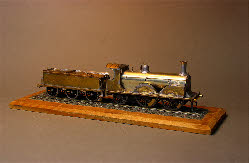



Updated February 2021
B1 (Gladstone) class no 184 ‘Stroudley’
 B1 class no 184 ‘Stroudley’ was one of the Gladstone class of express passenger engines which were a development of the Richmond class 0-
B1 class no 184 ‘Stroudley’ was one of the Gladstone class of express passenger engines which were a development of the Richmond class 0-4-2’s. They were themselves related to the Lyons class D2’s, and their famous tank engine precursors, the D1’s. Large coupled leading wheels were not much favoured by Stroudley’s contemporaries, but he reasoned that front-coupled engines saved length, weight and construction costs, as well as providing greater adhesion. Stroudley’s successor Robert Billinton disagreed, and consequently these were the last of the front-coupled expresses to be built for the Brighton line, later engines being either 4-4-0’s (B2, B3 and B4) or Atlantic 4-4-2’s.
The first of the class, ‘Gladstone’ entered traffic in 1882, and after a few months’ testing, a further five were built with minor modifications. No 184, originally named ‘Carew D. Gilbert’ was part of the second batch of engines built in 1889 out of a class which eventually totalled 36. No 184 was repainted in 1906 from Stroudley’s Improved Engine Green to Marsh’s two-tone umber. It was one of a very few engines to carry a name in this livery, and was renamed ‘Stroudley’ to commemorate its designer. Twenty-six of the class were taken into Southern Railway stock and no 184 was one of the longer lasting of its class, being withdrawn in 1930.
In 1891 Stroudley was shedded at Eastbourne, and may therefore have been seen through Plumpton.
My model is an Albion etched brass kit, although subject to a lot of necessary modification. The kit instructions say very clearly that it is suitable for OO/EM/P4, but I found the clearances impossibly tight. I had built the tender and part built the loco body before realising this, and had to dismantle the loco body to widen the splashers so that the coupling rods would clear running plate.

 On the left, the loco chassis, Mashima motor, High Level Roadrunner+ gearbox, fully compensated with sidebeams at the front, and a central pivot for the trailing wheels. On the right, the tender chassis with side beams at the rear, and a floating axle at the front. The leading axle is weighted down with lead on a beam which pivots about the rear axle compensation beam pivot.
On the left, the loco chassis, Mashima motor, High Level Roadrunner+ gearbox, fully compensated with sidebeams at the front, and a central pivot for the trailing wheels. On the right, the tender chassis with side beams at the rear, and a floating axle at the front. The leading axle is weighted down with lead on a beam which pivots about the rear axle compensation beam pivot.

 On the left is the nearly-
On the left is the nearly-finished engine, awaiting a few final bits and pieces - mainly the brakes, and on the right, finished and painted on its first outing on Plumpton Green.
B1 (Gladstone) class no 184 ‘Stroudley’
 B1 class no 184 ‘Stroudley’ was one of the Gladstone class of express passenger engines which were a development of the Richmond class 0-
B1 class no 184 ‘Stroudley’ was one of the Gladstone class of express passenger engines which were a development of the Richmond class 0-The first of the class, ‘Gladstone’ entered traffic in 1882, and after a few months’ testing, a further five were built with minor modifications. No 184, originally named ‘Carew D. Gilbert’ was part of the second batch of engines built in 1889 out of a class which eventually totalled 36. No 184 was repainted in 1906 from Stroudley’s Improved Engine Green to Marsh’s two-
In 1891 Stroudley was shedded at Eastbourne, and may therefore have been seen through Plumpton.
My model is an Albion etched brass kit, although subject to a lot of necessary modification. The kit instructions say very clearly that it is suitable for OO/EM/P4, but I found the clearances impossibly tight. I had built the tender and part built the loco body before realising this, and had to dismantle the loco body to widen the splashers so that the coupling rods would clear running plate.

 On the left, the loco chassis, Mashima motor, High Level Roadrunner+ gearbox, fully compensated with sidebeams at the front, and a central pivot for the trailing wheels. On the right, the tender chassis with side beams at the rear, and a floating axle at the front. The leading axle is weighted down with lead on a beam which pivots about the rear axle compensation beam pivot.
On the left, the loco chassis, Mashima motor, High Level Roadrunner+ gearbox, fully compensated with sidebeams at the front, and a central pivot for the trailing wheels. On the right, the tender chassis with side beams at the rear, and a floating axle at the front. The leading axle is weighted down with lead on a beam which pivots about the rear axle compensation beam pivot.
 On the left is the nearly-
On the left is the nearly-